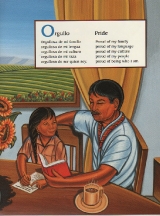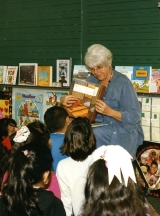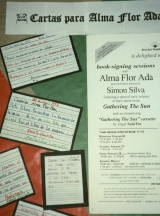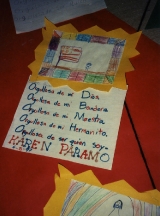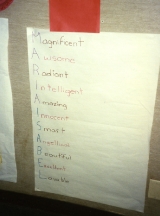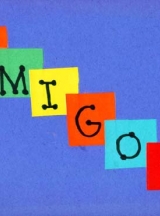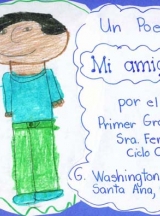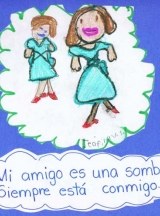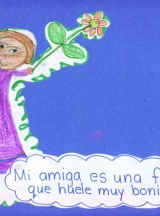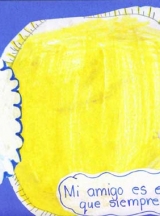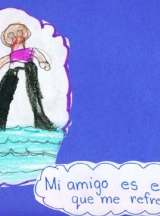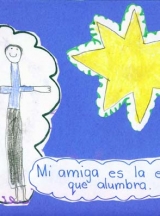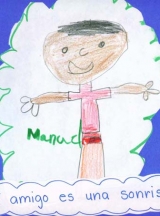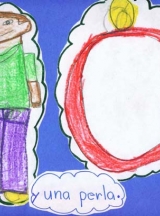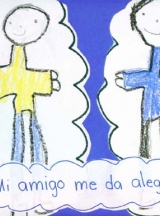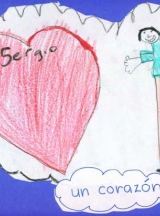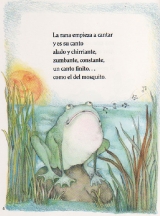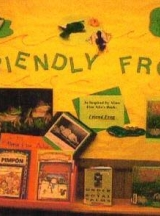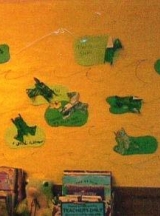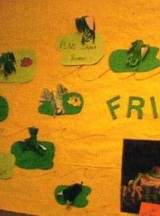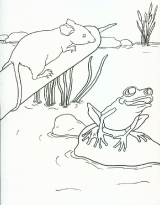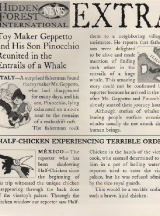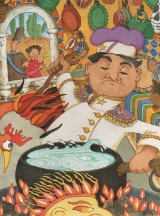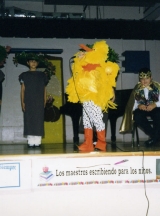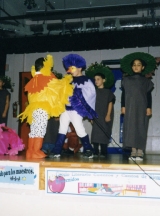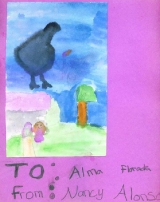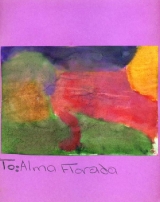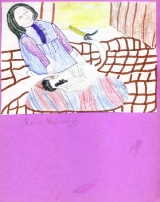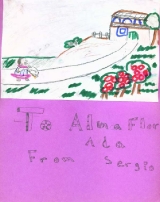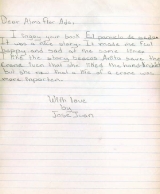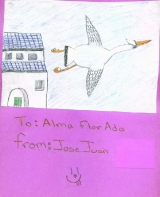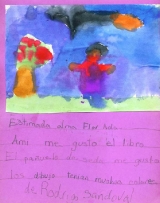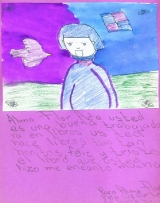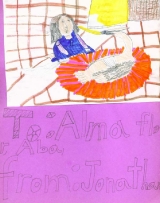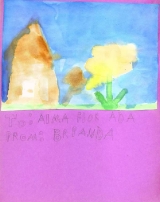Archive for November, 2009
Gathering The Sun: An Alphabet in Spanish and English
Friday, November 27th, 2009RECOGNITIONS
Best-selling Book!
Once Upon A World Book Award, Simon Weisenthal Center, 1998
NCSS/CBC Notable Book in the area of Social Studies, National Council of Social Studies and the Children’s Book Council
Pura Belpré Honor Book, American Library Association 1997
NCTE Notable Book in Language Arts, National Council of Teachers of English
“Pick of the Lists” American Booksellers Association
California Readers’ Collection, Elementary List
Commended List, Center for Latin American Studies
BOOK DESCRIPTION
The author’s many years of work with migrant families inspired this poetic ABC of the fields, in two languages, and Simón Silva’s magnificent illustrations, in bold colors, have created a work of art to be enjoyed by children and adults alike. (K-12).
CD DESCRIPTION
Suni Paz has drawn from her extensive knowledge of Latin American folklore for the inspirational music that turns the poems in this book into memorable songs, an irresistible invitation to listen, to enjoy, to sing along.
AUTHOR’S NOTE
Some of the most heartening experiences of my life have been my work with Migrant Farm Working families. I have described the academic results of sharing high quality children’s books with Migrant parents and inviting them to create books with their children in Pájaro Valley, California in the book A Magical Encounter: Use of Latino Literature in the Classroom. I have described my work with farm working parents, and the learning I derived from it, in my memoirs, Vivir en dos idiomas.
The poems of Gathering the Sun were born out of these enriching experiences. Simón Silva, who knew intimately the life in the fields during his childhood and has drawn from the heritage of the great Mexican muralists provided strong and magnificent illustrations that have made this book the true homage to the farm workers lives and struggles that I dreamt to create.
It has given me unsurpassable joy to sign this book for golden anniversaries of grandparents and for birthday gifts, for quinceañeras, newborn babies and babies yet to be born, realizing that in each case the book is a symbol of the strength, the resilience, the determination, the dignity and the profound love of family of those who work in the fields and whose labor allows us all to live.
Suni’s unique voice and her masterful compositions have allowed the words in this book to transcend their birth as poems becoming unforgettable songs. My gratitude to Suni and Simón, for allowing this homage to César Chávez and all campesinos to be as inspiring as his example and their lives.
REVIEWS
School Library Journal
Pre-School-Grade 5. An alphabet book with exceptional illustrations and excellent poetry that gives voice to the experience of Hispanic agricultural workers. Each letter is matched with a Spanish word (for example, “Arboles” for “A”) and accompanied by a poem in both Spanish and English that describes how the plant, fruit, vegetable, person, or feeling functions in the lives of these workers. Zubizarreta’s English translations are informed and graceful, but predictably cannot match the Spanish originals in rhythm, assonance, or meter. Silva’s vibrant, double-page, gouache illustrations are reminiscent of the artwork of Diego Rivera and Jose Clemente Orozco. The colors are brilliant, and the scope has a certain larger-than-life sense to it. This is a book that begs to be read aloud to all students, whether they are Spanish speaking or not. The sound of the poems will draw them in. The touching elegy for Cesar Chavez successfully imparts the impact of a heroic man on his people. Whether used to show the plight of migrant workers or the pride Hispanic laborers feel in their heritage, this is an important book. –Ann Welton, Terminal Park Elementary School, Auburn, WA Copyright 1997 Reed Business Information, Inc.
Booklist
Ages 5-8. Using the Spanish alphabet as a template, Ada has written 27 poems that celebrate both the bounty of the harvest and the Mexican heritage of the farmworkers and their families. The poems, presented in both Spanish and English, are short and simple bursts of flavor: “Árboles/Trees,” “Betabel/Beet,” “César Chávez,” etc. Silva’s sun-drenched gouache paintings are robust, with images sculpted in paint. Brimming with respect and pride, the book, with its mythic vision of the migrant farm worker, will add much to any unit on farming or Mexican American heritage. Annie Ayres
Curled Up with a Good Kid’s Book
Tapping into a rich cultural history of people working the land and harvesting its bounty, Gathering the Sun is brilliantly illustrated, a delightful adventure into the world of language and art, of “simple words and sun-drenched paintings.” More than just an alphabet book, it teaches children the basics of language in the context of family and tradition.
The illustrated alphabet is Spanish, text in both Spanish and English: “arboles (trees), “the companions of my childhood”; duraznos (peaches), “like a gentle caress in the palm of my hand”; tomates (tomatoes), “red tomato in the kitchen, in the little tacos my godmother loves to make”; zanahoria (carrot), “The carrot hides beneath the earth. After all, she knows the sun’s fiery color by heart.”
Through the text by Alma Flor Ada and wonderful art of Simon Silva, beginning readers explore orchards and fields beside those who plant and nurture the crops, the book dedicated to the living memory of César Chávez: “Your example and your words sprout anew in the field rows as seedlings of quiet hope.”
In a joyful celebration of tilling, toiling and the language of nature’s bounty, the text is bilingual, with particular attention to the harmony of words and the images wrought from the earth’s palette, the cycle of growth and those who labor to carry their fruits from field to kitchen, from the hands that tend the plants to those who prepare the spicy and textured foods that grace the tables of grateful families: “In the field row lies a seed, all tucked in like a baby in the crib.”
Gathering the Sun is nothing less than stunning, saturated with color and the shared dignity of hard work, a reflection of the author and illustrator’s appreciation for all aspects of growth, from field to heart to spirit, acknowledging “honor and pride, family and friends, history and heritage, and… the bounty of the harvest.”
–Luan Gaines/2006 for Curled Up with a Good Kid’s Book
papertiger.org
Whole World of ABCs and 123s
In her selection of bilingual books for reading to children, librarian Ana-Elba Pavon said of this beautiful, verse abecedario: it is “a tribute to working in the fields. A collection of poems, it includes Cesar Chavez, individual fruits and vegetables, and other Latino symbols. Use the poem under the letter “O” for “Orgullo” or “Pride” as a chant with your audience. Have them repeat each verse of the poem after you read it.” Absolutely!
Gathering the Sun: An Alphabet in Spanish and English by the prolific author Alma Flor Ada is by definition an alphabet book, but is a tribute to working in the fields. A collection of poems, it includes Cesar Chavez, individual fruits and vegetables, and other Latino symbols. Use the poem under the letter “O” for “Orgullo” or “Pride” as a chant with your audience. Have them repeat each verse of the poem after you read it.– Marjorie Coughlan
CITATIONS
The Children’s Literature Lover’s Book of Lists by Joanna Sullivan on page 64, page 278, and page 333
Valerie & Walter’s Best Books for Children 2nd Ed : A Lively, Opinionated Guide by Walter M. Mayes on page 41, and Index
In Sweet Company: Conversations with Extraordinary Women about Living a Spiritual Life by Margaret Wolff on page 69
The Reading Teacher’s Book of Lists (J-B Ed: Book of Lists) by Edward Bernard Fry on page 159
“Let’s Read : A Complete Month-by-Month Activities Program for Beginning Readers” by Elizabeth Crosby Stull in Back Matter
Image Gallery
READERS’ RESPONSES
If you have enjoyed reading or sharing this book, I would very much like to hear from you. Please click here to send your comments.
Friend Frog
Wednesday, November 25th, 2009RECOGNITIONS
Pick of the Lists American Booksellers Association
BOOK DESCRIPTION
Field Mouse wants a friend. A friend to share secrets. One day he spots Frog by the pond and she seems perfect. But when Frog invites him to play, Field Mouse despairs. Frog can croak; Frog can jump; Frog can swim! Field Mouse can’t. How will they ever be friends? Lori Lohstoeter has created the outstanding art for this book.
AUTHOR’S NOTE
This very book is very dear to me, because, you see… I’m Field Mouse. Not very good at many things others find easy to do, I admire my friends who can sing, play instruments, compose music, paint, dance, who excel in many ways… It’s good to know that, like Field Mouse, I can offer a true friendship!
A fascinating note on the making of the book. Wanting to be sure that Field Mouse would be drawn with total accuracy; Lori Lohstoeter reluctantly got herself a little mouse which she observed as she sketched for the book. This is why the pictures are so wonderful! Of course, once the art was finished she was too attached to her little friend to bring him back to the pet shop as she originally intended.
This is one of the books I delight to read to students during my school visits. It allows me to tell them that one can have many different kinds of friends and I share how my own life has been enriched by friends of all ages, diverse cultural backgrounds, and multiple professions from many parts of the World. And I also like to reflect with them on the fact that to have good friends one must first be a good friend!
Reviews
School Library Journal
Kindergarten-Grade 2-Poor Field Mouse is so wowed by Frog, who can jump, croak, and swim to beat the band, that he doubts whether the two of them can ever be friends. Then Field Mouse, who can’t do anything as well as Frog can, discovers there is something he can do. The acrylic-on-illustration-board paintings use strong lines and deep earth tones to create the world of the pond and the field that the two protagonists inhabit. Their expressions communicate worlds-Frog, a fun-loving, enthusiastic sort, and poor, meek Field Mouse, whose face exudes palpable yearning. Pair this with John Schindel’s I’ll Meet You Halfway (McElderry, 1993; o.p.) and Kerry Argent’s Wombat and Bandicoot: Best of Friends (Little, Brown, 1990; o.p.) for a storytime on the glories of friendship. – Ann Welton, Terminal Park Elementary School, Auburn, WA
Image Gallery
READERS’ RESPONSES
If you have enjoyed reading or sharing this book, I would very much like to hear from you. Please click here to send your comments.
Suggestions for a cultural infused curriculum which include this book can be found in The Alma Project from the Denver Public Schools. Click here.
Extra! Extra! Fairy-Tale News from Hidden Forest
Wednesday, November 25th, 2009BOOK DESCRIPTION
When the residents of Hidden Forest wake up and open their morning papers, they are in for a surprise. An enormous beanstalk has mysteriously sprouted outside of Jack Blake’s house, and Jack is nowhere to be found. Meanwhile, Pinocchio and Half-Chicken or Mediopollito have set out on adventures of their own, and Tortoise and Hare are off to the races. Will they all find their happy endings? Hidden Forest News has got the scoops. Written and laid out in newspaper format, this installment in the enchanting Hidden Forest series has received a new twist from Alma Flor Ada and Leslie Tryon. All of your favorite characters from Dear Peter Rabbit or Querido Pedrín, Yours Truly, Goldilocks or Atentamente, Ricitos de Oro; and With Love, Little Red Hen are back, but this time they are hitting the presses and making headlines!
AUTHOR’S NOTE
Publishing a book is always a long process, but sometimes it can be a VERY long process. That was the case of my latest book: Extra! Extra! Fairy-Tale News from Hidden Forest. Due to a series of mishaps, it took 9 long years to go from a manuscript to a book. But, now rejoicing in the great art of Leslie Tryon, it was worth the wait. This is a book I have gotten to like and love more each day…because it was born out of my love for newspaper –granddaughter of two newspaper men that I am– and because I believe that while fun and entertainment it will give children an opportunity to see two sides of an argument, and also to learn to read critically. When a giant beanstalk appears in Hidden Forest the town gets divided between those who feel that anything different is a menace that should be eliminated, and want to chop down the beanstalk immediately, and those who propose that there may be richness in diversity…
You can read Leslie Tryon’s reflections about the creation of the Hidden Forest series in the chapter she wrote for Alma Flor Ada and You, volume II published by Libraries Unlimited in the series The Author and You.
Image Gallery
REVIEWS
Kirkus Reviews:
Ada’s latest is a continuation of the Hidden Forest series of fairy-tales adventures, but this time, several editions of the Hidden Forest News newspaper replace the letters of the previous books. Subscribers follow many new stories, the most notable being the saga of the mysterious beanstalk and the related disappearance of Jack Blake. Op-ed pieces illustrate the controversy surrounding the beanstalk. Also newsworthy is the closing of Geppetto’s toy shop, the beginning of Half-Chicken’s journey to Mexico City (both International news) and the intended race between the Tortoise and the Hare (Sports). The “Back Page” lists the advertisements. Readers with a thorough grounding in fairy tales will laugh out loud at the allusions and double entendres that are the hallmark of Ada’s writing. Tryon’s busy full-color illustrations will keep readers’ attention as they search for hidden details. The newspapers themselves are illustrated with small tongue-in-cheek black-and-whites. Teachers of fairy-tale units will love the subtle teaching of newspaper content and layout. A must for every fairy-tale collection. (Picture book, 6-9).
School Library Journal:
Hidden Forest, which retold traditional fairy tales through a series of letters, this fourth installment uses a newspaper format. Through articles, opinion pieces, and even sports and … more » international pages, several issues of the Hidden Forest News provide the scoop on Jack and the Beanstalk and report on an Italian toymaker who as gone missing while searching for his puppet/son and a race betw between a hare and a tortoise. Headlines, columns, and black-and-white spot art tell Jack’s tale from a variety of viewpoints. Things are livened up by occasional full-color pages painted in bright watercolors that show Hidden Forest residents producing, delivering, and reading the paper. Fans of the series will find their favorite characters in the articles, editorial bylines, and even the advertisements (Mr. Wolfy Lupus is running a summer camp for children). While there is much fun here, the format does make the plot considerably more complicated. Readers unfamiliar with the featured stories may struggle to follow along, while older children who would enjoy the humor may be put off by art with such a young tone. Purchase where the other books are popular.
Horn Book:
“Unlike the first three books set in Hidden Forest, this installment forgoes letter-writing (With Love, Little Red Hen, rev. 1/02), instead comprising three issues of the Hidden Forest News (and a two-page extra edition). The paper covers local and international storybook headlines as well as sports, community happenings, and advertisements (touting, for example, the masonry services of Pig Three). Above-the-fold news is dominated by two local stories: the sudden appearance of a giant beanstalk-like plant and concern about the fate of Jack Blake, who traded the family cow for some beans. As with the previous books, the fun is in following familiar characters as they interact with one another and play out their well-known roles. The text-heavy newspaper format doesn’t lend itself to story-hour readings, but there are plenty of clever details in both text and art for readers to enjoy on their own. Tryon’s black-and-white drawings enliven the articles and features; full-page color illustrations between issues show, among other tableaux, Peter Rabbit on his paper route. The concept isn’t new (e.g., Colin and Jacqui Hawkins Fairytale News, rev. 7-04), but for Hidden Forest fans, Extra! Extra! Offers all the fairy-tale news that’s fit to print.”
Nugget:
Extra! Extra! By Alma Flor Ada (Atheneum, ages five to eight) gives all the scoops on fairy tale news as presented in the newspaper. When the residents of the Hidden Forest wake up and open their morning papers, they are in for a surprise. An enormous beanstalk has mysteriously sprouted outside of Jack Blake’s house, Pinocchio and Half-Chicken have set out on great adventures, and the great race between Tortoise and Hare fills the sports pages. Will they all find their happy endings? Hidden Forest News has got the scoops. Full-color watercolor-and-ink illustrations are scattered among the newsprint-toned sheets. Written and laid out in newspaper format, this new twist on familiar fairy tales is complete with fairy-tale ads, editorials, and a back page for children.
Booktalks
Extra! Extra! Read all about it. Boy trades family cow for beans. Giant beanstalk grows. Jack Blake disappears. Extra! Extra! Read all about it. Gepetto’s Toy Shop closing. Extra! Extra! Read all about it. In sports today, we have coverage of the race between the Tortoise and the Hare. Extra! Extra! Read all about it. Lots of interesting stories in these newspapers! — http://nancykeane.com/booktalks/ada_extra.htm
READERS’ RESPONSES
If you have enjoyed reading or sharing this book, I would very much like to hear from you. Please click here to send your comments.
Escenas y alegrías
Wednesday, November 25th, 2009BOOK DESCRIPTION
Three well loved stories have been the source for the four plays created for this anthology by Alma Flor Ada and F. Isabel Campoy.
The delightful tale of Martina Martínez and Ratón Pérez has been dramatized here as two plays: La Cucarachita Martina and El Ratón Pérez. The traditional tale of Chicken Little has been dramatized as Pedro Pollito. The fourth play is a dramatization of the book Amigos by Alma Flor Ada. The text for the play comes from the retelling in verse of the story, with music by Suni Paz, which can be found on the CD Libros para contar. If any teacher would like to engage young children in a musical performance this play can turn into a simple but powerful musical.
The charming language, the use of rhyme and cumulative text make these plays easy to perform and a continuous language enrichment.
The illustrations provide suggestions for staging and customs.
The values of the use of involving children with theatre are multiple. Plays can be an excellent tool for promoting the ability to speak in front of a group, which is a leadership skill. Since they offer children the opportunity to utilize words and language registries they may not have other opportunity to use, plays can be strong vehicle for vocabulary and language development.
When used for choral reading plays can strengthen reading skills. In addition, acting in a play enhances children’s self-confidence and self-esteem while providing opportunities to learn about one’s self and others. Most importantly, putting on a play, no matter how simply, promotes the values of collaboration and solidarity.
To read more on the significance of theatre click here: Let’s Raise the Curtain! The Benefit of Theatre in the School and for suggestions on its use in the classroom read the section “Plays and Dramatic Games” in Chapter 3 of A Magical Encounter: Latino Children’s Literature in the Classroom and for dramatic responses to books, the section “Promoting Dramatic Expression” in Chapter 4 of that same book.
AUTHOR’S NOTE
Promoting that children have access to read and act plays has always been one of my basic concerns. Even if it is done with great simplicity acting in a play can have very positive results. It certainly was so for me. Encouraged by my extraordinary sixth grade teacher, Dra. Rosa María Peyrellade, I wrote my first play which we performed in class. As a high school student I wrote three plays, and while very simple, my classmates performed them with enthusiasm. We invited the High School Faculty of the Instituto de Camagüey to the premier of one of them, which I entitled La sonámbula or The Sleep-walker. Even though some of the professors did not enjoy the criticism to their very traditional pedagogy which was part of the play, there was enough interested public that we rented the best theatre in town, el Teatro Principal, to give a couple of public performances.
When I became a High School teacher at the Colegio Abraham Lincoln in Lima, Perú, I invited my students to do theatre and we had great fun doing so!
My mother, a coordinator for FLES [Foreign Language in the Elementary School] in Atlanta, Georgia, used theatre very effectively in the teaching of Spanish, and wrote a number of plays that were performed by children and broadcasted via the district TV station.
As a teacher educator in the United States I have continuously emphasized the use of theatre. I have had the privilege of having my mother co-direct with me three different performances of Historia de una muñeca abandonada, by Alfonso Sastre during three summer courses: at the University of Texas, at El Paso, in Philadelphia, and in Puerto Rico. I was later able to continue to invite teachers to perform this outstanding play, in Chicago, through the Associate Colleges of the Midwest, and in Madrid, both at the Universidad Complutense and at the Fundación José Ortega y Gasset. This play is included in this collection in the book Ensayo general.
I am convinced that one is better able to teach something one has enjoyed doing. And just as Isabel Campoy and I emphasize, in our courses of Authors in the Classroom, that teachers who create their own books will be better able to get their students to become authors, I believe that encouraging teachers to do theatre and experiencing the richness of the process would better allow them to incorporate plays in their regular teaching.
For a delightful anecdote that shows the magic of theatre click here: Let’s Raise the Curtain! The Benefit of Theatre in the School.
You can also find more about my personal experience with theatre in the section “It’s Play Time!” in Alma Flor Ada and You volume II, published by Libraries Unlimited.
ABOUT THE CIELO ABIERTO THEATRE COLLECTION
Each of the seven anthologies in this series offers a variety of plays well-suited for either reading aloud or for full-scale performance. For the early grades, Alma Flor Ada and F. Isabel Campoy have created original adaptations of traditional children’s stories. Familiar tales are retold in the form of plays, choral poems, and theatre games, inviting children to explore movement, characterization, and imaginative play. The use of traditional Hispanic folklore, woven into the dialogue, enhances the cultural setting in which the stories have been recast. For the older grades, a selection of the best plays written for children throughout the Spanish-speaking world has been carefully assembled.
The anthologies are:
- Primer acto [PreK-2] 48 pages
- Risas y aplausos [K-3] 48 pages
- Escenas y alegrías [1-4] 48 pages
- Actores y flores [3-6] 64 pages
- Ensayo general [4-7] 80 pages
- Saludos al público [5-8] 96 pages
- Acto final [5-8] 96 pages
Teachers have found the anthologies in this collection both inviting and inspiring.
READERS’ RESPONSES
If you have enjoyed reading or sharing this book, I would very much like to hear from you. Please click here to send your comments.
El vuelo de los colibríes
Wednesday, November 25th, 2009BOOK DESCRIPTION
A grandmother’s story of her childhood in rural Mexico and her family’s decision to come to the United States allows her granddaughter to feel pride in their family legacy of endurance and courage. This is an ideal book for exploring issues of migration, immigration and family legacies.
AUTHOR’S NOTE
My work of many years with migrant farm working families has been one of the most enriching experiences in my life. I reflect on how much I have been inspired by their lives of struggle and resilience, by their dignity and family values, in my memoirs Vivir en dos idiomas. These experiences have also inspired much of my writing. The poems of Gathering the Sun are a tribute to their lives. Suni Paz has created original music for those poems and recorded as songs in a CD with the same title. In the book Imágenes del pasado, I have included a piece, “Teatro campseino, ¡que florezca la luz!” about the important role of the Teatro campesino in the Farm workers struggle. Isabel Campoy and I have written the biographies of César Chavez, for the book Paths or Caminos in the series Gateways to the Sun or Puertas al sol and the biography of Luis Valdes for the book Voices or Voces of the same series.
In this book I have incorporated many anecdotes told to me by various families and by some of my doctoral students along the years. I wanted to create a coherent narrative that will show the plight of the Mexican campesinos, their love of family, and their determination to struggle to support their loved ones. The hard working spirit, the resilience, the solidarity, and the love passed on through generations in this story all reflect the values I have witnessed in hundreds of farm working families and wanted to honor.
READERS’ RESPONSES
If you have enjoyed reading or sharing this book, I would very much like to hear from you. Please click here to send your comments.
El verde limón
Wednesday, November 25th, 2009BOOK DESCRIPTION
This oversize book, with 48 pages, is rich in delightful poetry by some of the best poets who have written in Spanish for children. It includes poetry by Isabel Freyre de Matos, Dora Alonso, Fryda Schultz de Mantovani, Juana de Ibarborou, Esther Feliciano Mendoza, José Antonio Dávila, Antonio Ramírez Granados as well as original poetry by Alma Flor Ada and F. Isabel Campoy.
AUTHOR’S NOTE
Poetry is one of the best gifts we can give children. A poem a day enhances a child’s life with the sounds of words, with rhyme and rhythm, with the enchantment of images and metaphors, with the invitation to see reality with new eyes.
Our culture is very rich in outstanding poets and excellent poetry. Some poets write primarily for children, but even our most recognized poets have at some time or other written poetry that children can enjoy.
The Cielo abierto Poetry Collection collection is composed of seven poetry anthologies. These rich anthologies include selections from the folklore along with the work of the best Spanish-speaking poets from the United States, Latin America and Spain. Each of the selections has been carefully chosen to awaken children’s love of poetry and to deepen their appreciation for the musicality and richness of the Spanish language. Original poems by Alma Flor Ada and Isabel Campoy are also included.
It is impossible to assign a specific age to poetry, since the same poem can be enjoyed by children of different ages at different moments. Yet, there is a certain progression of language and reading difficulty in the series reflected in the order in which the titles are listed.
Grade levels have been mentioned next to the titles as an orientation, but should not be seen restrictively.
The titles are:
- Gorrión, gorrión [PreK-2] 64 pages
- El verde limón [K-3] 48 pages
- Dulce es la sal [K-3] 48 pages
- La rama azul [2-5] 64 pages
- Nuevo día [2-5] 64 pages
- Huertos de coral [5-8] 128 pages
- Ríos de lava [5-12] 128 pages
READERS’ RESPONSES
If you have enjoyed reading or sharing this book, I would very much like to hear from you. Please click here to send your comments.
El reino de la geometría
Wednesday, November 25th, 2009BOOK DESCRIPTION
Everyone lives happily in the Kingdom of Geometry until King Square VII comes to the throne, Persuaded by his courtiers that a square is the perfect figure, with four identical sides and four square angles, he decrees that only squares shall be allowed in the palace and in the town. It takes much ingenuity and determination on the part of a young square named Rose, to free the remaining figures from the king’s rule. This is a story to initiate reflections on injustice, discrimination and racism, as well as possible responses to oppression. The illustrations are by the famous Spanish artist José Ramón Sánchez.
AUTHOR’S NOTE
The struggle against oppression and the need to eliminate racism are constants in my life, thus it is not surprising that they come out in several of my stories, sometimes unconsciously. The name Rose of the little square who would not accept the king’s ruling and who found and intelligent and peaceful way of overcoming the injustice done unto others is a small tribute to my daughter Rosalma Zubizarreta, who has devoted her life to promote peace, solidarity and social justice.
READERS’ RESPONSES
If you have enjoyed reading or sharing this book, I would very much like to hear from you. Please click here to send your comments.
Dulce es la sal
Tuesday, November 24th, 2009BOOK DESCRIPTION
This poetry anthology with lively illustrations from three gifted artists includes original poetry by Alma Flor Ada and Francisca Isabel Campoy as well as poems from a number of poets from Latin America and Spain, including such renowned poets as José Martí and David Chericián, from Cuba; Gabriela Mistral, and María de la Luz Uribe, from Chile; Amado Nervo and Ernesto Galarza, from Mexico; María Elena Walsh and José Sebastián Tallón, from Argentina; Ester Feliciano Mendoza and Isabel Freire de Matos, from Puerto Rico; Morita Carrillo, from Venezuela; Carlos Murciano and Marina Romero from Spain. Other poets included are: Tomás Allende, Tomás Calleja Guijarro, Rodolfo Dada, Horacio Guillén, Floria Jiménez, María Hortensia Lacau, Emilio Teixidor, Fryda Schultz de Mantovani, Celia Viñas Olivella.
AUTHOR’S NOTE
Poetry is one of the best gifts we can give children. A poem a day enhances a child’s life with the sounds of words, with rhyme and rhythm, with the enchantment of images and metaphors, with the invitation to see reality with new eyes.
Our culture is very rich in outstanding poets and excellent poetry. Some poets write primarily for children, but even our most recognized poets have at some time or other written poetry that children can enjoy.
The Cielo abierto Poetry Collection is composed of seven poetry anthologies. These rich anthologies include selections from the folklore along with the work of the best Spanish-speaking poets from the United States, Latin America and Spain. Each of the selections has been carefully chosen to awaken children’s love of poetry and to deepen their appreciation for the musicality and richness of the Spanish language. Original poems by Alma Flor Ada and Isabel Campoy are also included.
It is impossible to assign a specific age to poetry, since the same poem can be enjoyed by children of different ages at different moments. Yet, there is a certain progression of language and reading difficulty in the series reflected in the order in which the titles are listed.
Grade levels have been mentioned next to the titles as an orientation, but should not be seen restrictively.
The titles are:
- Gorrión, gorrión [PreK-2] 64 pages
- El verde limón [K-3] 48 pages
- Dulce es la sal [K-3] 48 pages
- La rama azul [2-5] 64 pages
- Nuevo día [2-5] 64 pages
- Huertos de coral [5-8] 128 pages
- Ríos de lava [5-12] 128 pages
READERS’ RESPONSES
If you have enjoyed reading or sharing this book, I would very much like to hear from you. Please click here to send your comments.
